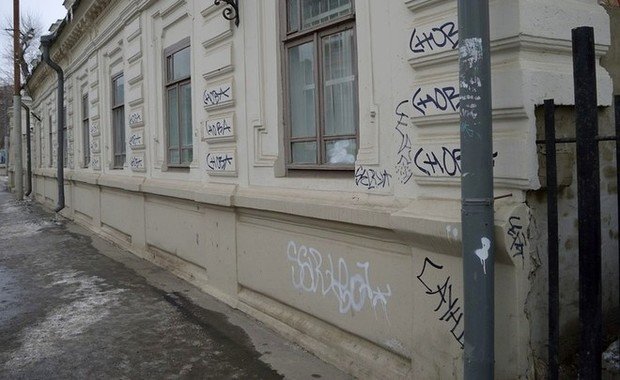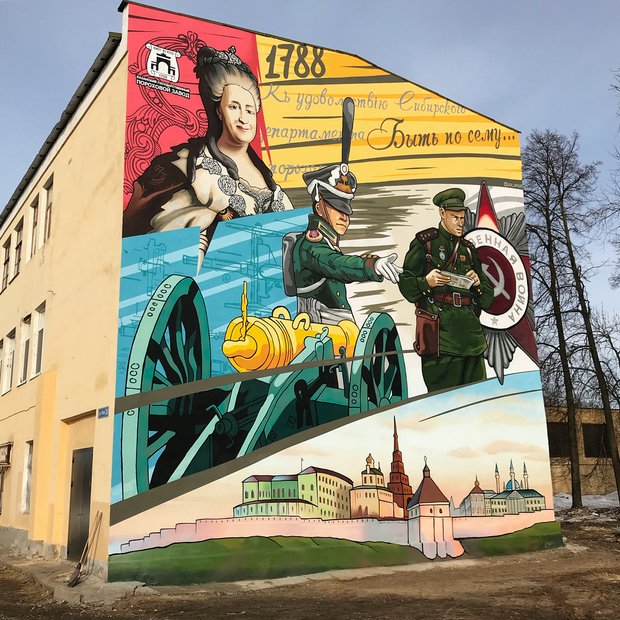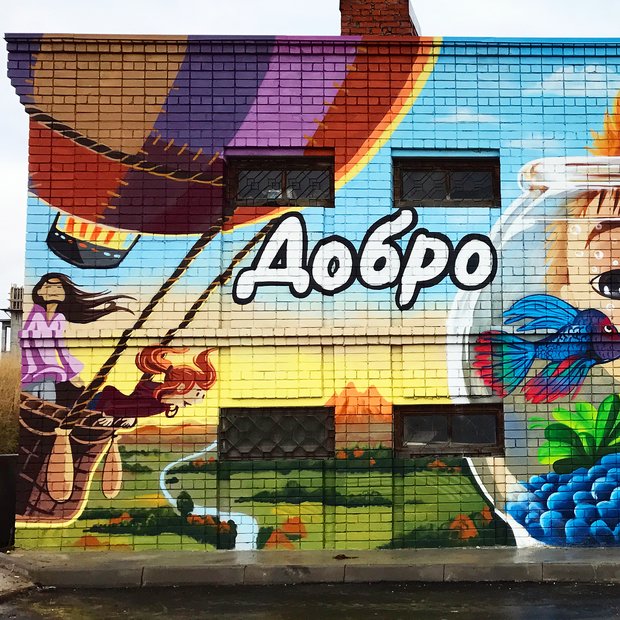Sly Dog: ''People started to consider graffiti not as vandalism but an art form''
Azat Aleyev, author of the graffiti to the Powder Factory, about Banksy and cultural gap with the West
New big graffiti dedicated to the 230th anniversary of the Powder Factory appeared in Kazan. Realnoe Vremya reached out to the painting's author – famous Kazan street artist Azat Aleyev (Sly Dog) who told about his new project. Our interlocutor tells about the attitude of authorities to paintings on buildings and vandalism.
''Works do appear in Kazan, but they fail to remain for even one-two days''
Azat, how did your road to street art begin?
Everything began in 2000 when my family lived in Moscow. I saw graffiti on walls first – it impressed and interested me a lot. I decided that one day, at some conscious age, I would certainly get a can. In general, I've painted all my life, I studied in an art school as a kid, so I think it's quite logical that I became interested in a new technique by discovering this art.
No less than 10 years passed until I got a can. I think the absence of specialised shops in Russia played its role. They started to appear only by the middle of the 2000s – the art of graffiti started to gradually germinate in our country. I will notice that this art in Russia is still at the stage of formation and entrance to a more or less acceptable level.
I found a specialised shop with paints in Kazan, bought five-six cans there, while my parents permitted me to paint on our garage (so we did without vandalism). Of course, I thought that everything would be much easier, but it turned out it was quite a complicated process: paint flows, it doesn't obey, the can behaves unpredictably, and I couldn't paint well. On that day, I looked at the works I had seen in a different way and understood it's quite difficult to do even simple paintings well.
But the desire to paint was stronger than my lack of self-confidence, and I kept on painting. As time went by, I switched from typefaces to more interesting works. And about two years later I achieved quite an acceptable level of painting. And to my surprise, I started to get commercial offers. After five-six years of practice, I completely plunged into this activity. And now, apart from painting (both for myself and on a commercial basis), I am giving courses. I also opened one of the first graffiti shops in Kazan.
How big is the graffiti community in Kazan? I think we don't have so many teams.
Thank God, we have a graffiti community, in general. Unfortunately, it's not as developed in Kazan as we'd like. I don't know the reason. When you enter other Russian cities, it immediately stands out that the graffiti activity in same Nizhny Novgorod, Perm, Yekaterinburg (not to mention Moscow and Saint Petersburg) is higher than here.
Works do appear in Kazan, but they fail to remain for even one-two days – they are either immediately painted over or deleted. We also have works we approved, it gladdens that people (first of all, I'm talking about those who started to produce street art) started to consider graffiti not as vandalism but art, which is present not only underground.

We also have works we approved, it gladdens that people (first of all, I'm talking about those who started to produce street art) started to consider graffiti not as vandalism but an art form, which is present not only underground
''Vandalism is detrimental. It's a dead end for an artist himself''
How drastically do you think the attitude to graffiti has changed in Russia in the last years? Earlier not all people were ready to consider it as real art, while now municipal authorities themselves turn to graffiti artists to paint a facility.
Street artists managed to show they were able to do profound, monumental works with a deep sense, that they could address people through graffiti. I think it is one of the reasons for positive changes. It also grabs that a person doesn't need to go to an art gallery or exhibition to look at some works – he can just go along the street and look into paintings. In my opinion, this is the power of graffiti. In the end, authorities understood that graffiti was another way to address people, caused some positive emotions in them, created a certain atmosphere in the city.

''Vandalism remains, of course, and it's unlikely to disappear, as there will always be people for whom this activity will be interesting from a perspective of ''primitive graffiti'' that existed in the 70s.'' Photo: Maria Gorozhaninova
Vandalism remains, of course, and it's unlikely to disappear, as there will always be people for whom this activity will be interesting from a perspective of ''primitive graffiti'' that existed in the 70s. I will remind that this movement was born in America and used to express a protest. In my opinion, vandalism is detrimental. It's a dead end for an artist himself. Graffiti becomes a much more powerful tool when they have a positive and deep sense.
Despite the positive dynamics, how big the cultural gap with the West is where works of same Banksy are estimated at thousands of dollars?
In general, Banksy is a separate topic. There is an opinion, which I agree to a greater degree with, that it is just a commercial project, which has not one person but a team of talented marketing experts and sales managers behind. They created a fictitious character and earn from it well. Yes, an element of street art is present here, but it's rather a talk about business.
As for the gap between Russia and the West. Here we should probably be talking about the thinking of population in different countries. Not I should tell you that we have a different mentality. Even what I paint sometimes causes many questions among passers-by: ''What's that? Why are you painting it? Paint flowers, paint the sun!'' In Europe, there are many doubtful and some provoking works done on huge façades. I'm afraid to imagine what would have happened if I had painted something similar in Russia.
I immediately remember ''Like It. Art'' festival in Kazan, at which street artists from all planet participated. During the festival, artists depicted a girl with sheep's head on one of the buildings on Kosmonavtov Street. This work was really cool, and in Europe, it would be considered from a perspective of art. Unfortunately, in Kazan, this work wasn't understood, and people started to complain a lot. It seems to be an inoffensive thing, but it was given a hostile reception.
Yes, the cultural gap is quite big, and we have a lot to reach the street art existing now abroad. But to do justice, I need to say we began 20 years later – the first graffiti in Russia appeared in 1993 when a flow of information rushed into the country, and people knew about many things they had never heard about before.

''Nowadays the work has already been completed – I drew the last elements on 12 April. In general, the work on these graffiti began as early as 1,5 months to starting the façade''
You've recently started to work on a new graffiti project – to the 230th anniversary of the Powder Factory. Can you tell about the project? What stage is the project in now?
Nowadays the work has already been completed – I drew the last elements on 12 April. In general, the work on these graffiti began as early as 1,5 months to starting the façade. The discussion started in winter, a small contest for artists was held. We had a task – to feature the factory's whole history as much as possible, the history was quite rich. I had many different options. I had to delete some elements of history from previous drafts not to overload the painting. In the end, there was a balanced draft I added my style to – it was chosen as a suitable option. Speaking about the financial aspect, the very factory is responsible for financing, equipment.
''I agree my works every time. Why should I push my luck once again?''
A bit above we already started to talk about the attitude of authorities to graffiti. I want to go back to this topic. There were cases in Russian cities when utility workers simply painted over excellent paintings and portraits (for instance, in case of the memorial to the victims of the terrorist attack in the Petersburg metro). What do you think of such barbarianism? Have your works been ever treated this way?
We should look at the situation objectively. I don't argue that it's not a very nice act to paint the memorial over but quite logical from a juridical point of view. If municipal authorities or owners of the block of flats didn't give official permission for the work, it's 100% vandalism, without depending on what will be painted there. However, from a humane perspective, it's not a very nice act.
There is a team in Petersburg that had been painting cool portraits of famous people for a long time. All these portraits were quickly painted by utility services. But the guys anyway came and painted another person over the fresh paint. I don't know, maybe it's their way of life. But if I were they, I'd try to agree with somebody and got the wall.

If it's a grandiose project, one should understand it's planned beforehand. And if it's planned beforehand, one can send an application beforehand not to wait then. I don't see any problems here and complications with the same paperwork
I painted on electrical substations in yards and got permissions for this in the Committee for Architecture. I have all documents for these paintings, and they are still there, nobody has touched them. When you decide to do something cool for people but don't agree your work – it's a very vulnerable moment. Your painting can be painted over in an hour, and you can say nothing to them. I agree my works every time. Why should I push my luck once again?
You are, undoubtedly, correct. But not all people are ready to deal with this bureaucratic process.
The devil is not so black as he is painted. In this respect, the system has significantly softened in recent time. Speaking about the time spent, according to official norms, it can take up to 30 days to process an application, in practice, one doesn't have to wait for so long. If it's a grandiose project, one should understand it's planned beforehand. And if it's planned beforehand, one can send an application beforehand not to wait then. I don't see any problems here and complications with the same paperwork.
Azat, many thanks for the talk! In the end, I want to ask you, do you see yourself in this sphere in the future, maybe in ten years?
Yes, I plan to work in this area further one, develop. I try to perfect every new work, I try to develop my style, I try to make up something that's mine and add something new to this sphere. And the participation in this activity not only in Russia but around the world is also among the goals, of course.